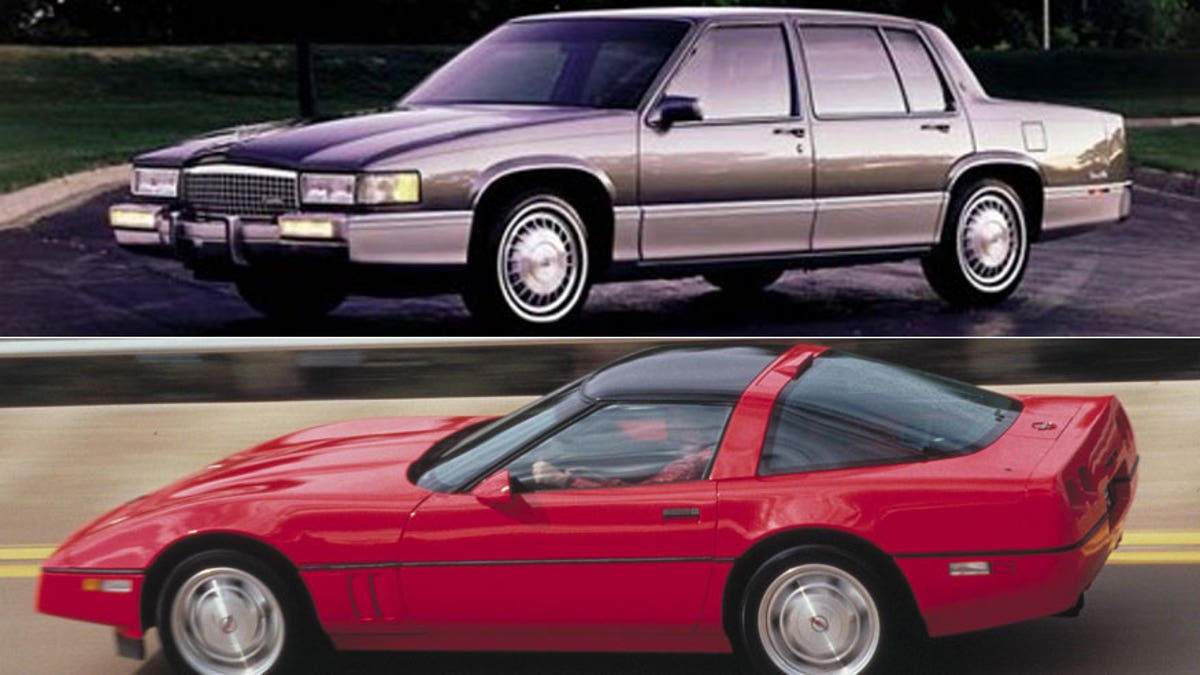
Cadillac Deville/Corvette ZR-1 (GM)
It was the year that Berlin Wall fell and the movie “Batman” dominated the multiplex. We were listening to Phil Collins and reading Tom Clancy’s newest book, “Clear and Present Danger.” It was 1989.
And if you own a car from that year, it’s now 25 years old, making it eligible for antique status under many state laws and the bylaws of the Antique Automobile Club of America.
Don’t have one from 1989? Here are some of the significant new models from that year. Get ready – you’re about to feel a little older.
BMW 5-Series
These days, products are redesigned every three to five years. So it’s hard to imagine that it took BMW 14 years to redesign the 5-Series. The new body was 3.2 inches shorter and 2 inches wider than the first generation model, but sported a 5.4-inch longer wheelbase. You could buy this model two ways: as the 168-horsepower 525i or the 209-horsepower 535i. A five-speed manual transmission was standard.
Buick Riviera
In an effort to rekindle slumping sales, Buick restyled the Riviera by adding 11 inches to its length, mostly in the rear. Despite being longer than the full-size Electra, the redesigned Riviera didn’t add any passenger space to its cramped cabin. While the restyle did recall the more popular 1979-85 Riviera, the new looks were more baroque. A 165 hp 3.8-liter V-6 and four-speed automatic powered the front-wheel-drive luxury coupe.
Cadillac DeVille/Fleetwood
A disastrous downsizing and lackluster sales led Cadillac to lengthen and restyle the DeVille and Fleetwood to woo back buyers who still equated size with luxury. Coupes gained 5.8 inches in length; sedans added 8.8 inches. The resizing added both legroom and trunk space, and allowed designers to revamp the interiors. A 155 hp V-8, four-speed automatic transmission and anti-lock brakes were standard.
Chevrolet Corvette ZR-1
The limited edition ZR-1, dubbed the “King of the Hill” by Chevrolet, helped re-establish the Corvette’s performance credentials. Its all-aluminum, double-overhead cam 5.7-liter LT5 V-8 was developed with Group Lotus, the British car company then owned by GM. The ZR-1’s V-8 was rated at 375 horsepower, 125 horsepower more than the standard Corvette, and could reach 60 mph in about four seconds.
Ford Probe
In what could be described as some of the worst product planning ever devised, Ford initially designed the front-wheel-drive Probe as a replacement for the rear-wheel-drive Ford Mustang. When word leaked out, Mustang fans’ outrage saved the pony car; the Probe was sold alongside it. Mazda four-cylinder engines powered the Probe, delivering a mere 145 horsepower, or 110 in the base model. Clearly it was no Mustang.
[Video: Generation Gap Cult Classics: Corvair vs. Fiero]
Ford Thunderbird/Mercury Cougar
How’s this for luck? The year that GM killed its popular rear-wheel-drive coupes in favor of new front-wheel-drive models, Ford redesigned theirs while retaining rear-wheel-drive. While shorter than previous models, both cars boasted a longer wheelbase and sleek, handsome styling. Power came from a 3.8-liter V-6 that developed 140 horsepower without a supercharger or 210 horsepower with one. Either a five-speed manual or four-speed automatic transmission was available.
Hyundai Sonata
Looking at this bland box, you’d never guess that it was the product of noted Italian designer Giorgio Giugiaro, who also designed Hyundai’s first American product, the 1985 Excel. But unlike the Excel, which was largely a recycled Mitsubishi, the Sonata was engineered in-house. A 116 hp 2.4-liter four-cylinder engine was standard; a 142 hp 3.0-liter V-6 was optional. An uninspiring start of a nameplate that is now the epitome of midsize car fashion.
Nissan 240SX
When the 200SX returned for 1989, it got a new name, the 240SX, that was meant to evoke the classic 240Z sports cars of the 1970s. Available as a notchback or hatchback, the 240SX returned for the new model year with stunning good looks and much to recommend it, including rear-wheel drive, 140 hp 2.4-liter engine and such options as a head-up display, which projected the car’s speed onto the windshield.
Nissan Maxima
When Nissan’s most luxurious model exchanged its boxy look for new aerodynamic styling, buyers took notice. Of course, it didn’t hurt that this new Nissan was 6 inches longer than the 1988 model and was now considered a midsize car. Front-wheel drive and a 160 hp V-6 from the 300ZX sports car were standard. A head-up display, which projected the car’s speed onto the windshield, was optional.
Pontiac 20th Anniversary Trans Am
It’s an old ploy. To extract maximum profit from an aging model, automakers tart up cars with paint and trim and offer them as limited edition models at a higher price. And while this Pontiac had its share of special trim, including white paint and tan-colored seating, it also got a very special engine under the hood: the 250 hp 3.8-liter V-6 previously used in the Buick Regal Grand National. A four-speed automatic transmission was standard. A mere 1,500 were built.
Porsche 911 Carrera 4
Known internally as the Type 964, Porsche’s newest iteration of the 911 debuted with four-wheel drive, anti-lock disc brakes and 250 horsepower from its 3.6-liter six-cylinder engine. Although the new Porsche’s look was familiar, the car boasted vastly improved aerodynamic properties. Its coefficient of drag, a measure of wind resistance, dropped to 0.32 from 0.59 on the old 911.
Toyota Cressida
Two years before the debut of Lexus, the restyled Cressida was Toyota’s most luxurious model in the United States. Styling was fairly staid on this rear-wheel-drive sedan. A 190 hp 3.0-liter V-6 used in the Supra sports car powered the Cressida through a standard four-speed automatic transmission. Anti-lock brakes and a CD player were among the options.
Other new or facelifted 1989 models: Buick Century, Dodge Colt, Dodge Spirit, Eagle Summit, Mazda MPV, Oldsmobile Cutlass Ciera, Plymouth Acclaim, and Pontiac Grand Am.
Click here for more from Hagerty, or sign up for our Classic Car Newsletter.